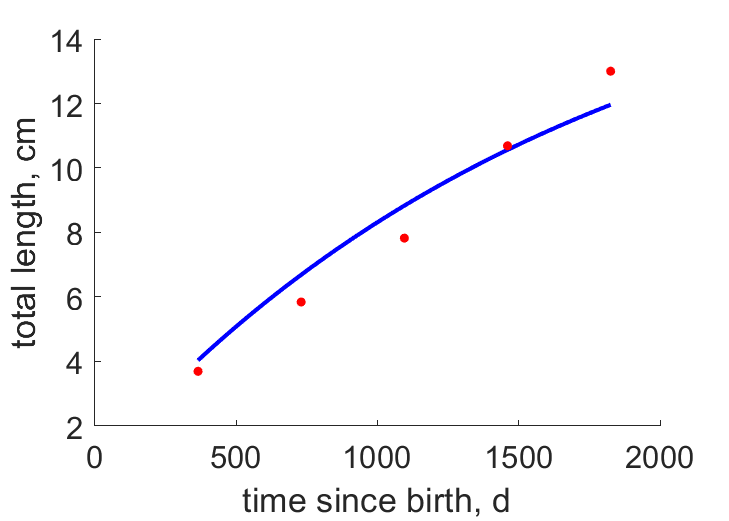Predictions & Data for this entry
| Model: std | climate: Cfa | migrate: Mp | phylum: |
| COMPLETE = 2.5 | ecozone: THn | food: biD | class: |
| MRE = 0.039 | habitat: 0iFc | gender: Dt | order: |
| SMSE = 0.004 | embryo: Ft | reprod: Os | family: |
Zero-variate data
| Data | Observed | Predicted | (RE) | Unit | Description | Reference |
|---|---|---|---|---|---|---|
| am | 2920 | 2925 | (0.001848) | d | life span | Wiki |
| Lp | 6 | 5.935 | (0.0109) | cm | total length at puberty | DockBeam1994 |
| Li | 18 | 17.83 | (0.009347) | cm | ultimate total length | fishbase |
| Wwb | 0.00052 | 0.0005158 | (0.008071) | g | wet weight at birth | fishbase |
| Wwp | 0.26 | 0.2616 | (0.006205) | g | wet weight at puberty | fishbase |
| Wwi | 7 | 7.097 | (0.01383) | g | ultimate wet weight | fishbase |
| NR | 5900 | 5821 | (0.01335) | # | eggs at the end of life | DockBeam1991 |
Uni- and bivariate data
| Data | Figure | Independent variable | Dependent variable | (RE) | Reference |
|---|---|---|---|---|---|
| tL |  | time since birth | total length | (0.08192) | DockBeam1994 |
Pseudo-data at Tref = 20°C
| Data | Generalised animal | Lampetra aepyptera | Unit | Description |
|---|---|---|---|---|
| v | 0.02 | 0.01901 | cm/d | energy conductance |
| p_M | 18 | 13.89 | J/d.cm^3 | vol-spec som maint |
| k_J | 0.002 | 0.002 | 1/d | maturity maint rate coefficient |
| k | 0.3 | 0.471 | - | maintenance ratio |
| kap | 0.8 | 0.6954 | - | allocation fraction to soma |
| kap_G | 0.8 | 0.7996 | - | growth efficiency |
| kap_R | 0.95 | 0.95 | - | reproduction efficiency |
Discussion
- assumption: Ww_i excludes eggs
Facts
- spawns once at end of life; no feeding as adult, no parasitic stage (Ref: Wiki)
- length-weight: Ww in g = 0.00120*(TL in cm)^3 (Ref: fishbase)
- Ammocoetes do not have a predetermined sex; instead, they all rapidly produce eggs until about 17 months of age. Sex is determined by environmental factors including stream temperature, population density, average growth rate, and pH. Males then re-absorb the eggs, though it is not uncommon for male ammocoetes to still have eggs in their testes. (Ref: DockBeam1994)
Bibliography